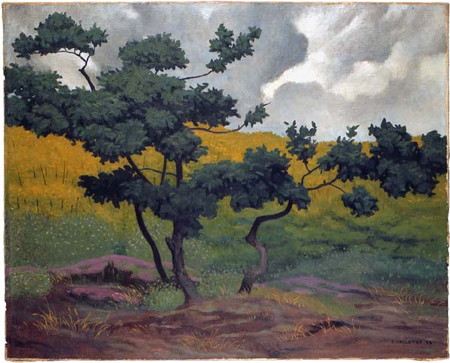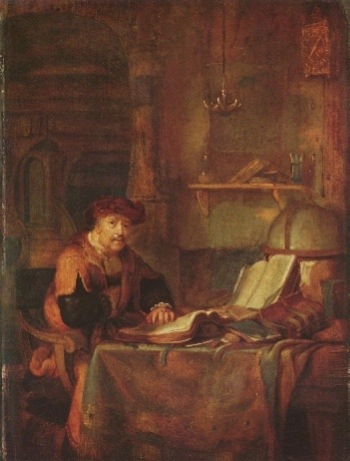From Under Milkwood
Dylan Thomas
Still Life with Words
Starry Night over the Rhone
Vincent Van Gogh
http://en.wikipedia.org/wiki/File:Starry_Night_Over_the_Rhone.jpg
There was an article in the Chronicle for Higher Education, “Poetry Makes You Weird,” suggesting that reading poetry affects us in strange ways; it causes us not only to see things in ways we had not considered before, but through these odd ways of looking reveals what is real or some hidden truth about the thing. Poetry opens our eyes to aspects of the world around us that are not easy to see or, perhaps, are just taken for granted and are not consciously seen or heard though they are right in front of us. There is a sense that this is true about all Literature and is part of what makes the study of Literature valuable.
There were a series of articles recently in The Guardian about “darkness” in literature that illustrates this point. One of these articles, “Darkness in literature: Under Milk Wood by Dylan Thomas,” looked at the opening lines to Dylan Thomas’ play for voices Under Milk Wood. I have enjoyed this play from the first time I read it (not least because the name of the mythical Welsh town where the play takes place, Llareggub, is “buggerall” spelled backwards, an expression my father was wont to use on comic occasions). The opening lines describe the dark of night in the early hours of the morning.
It is spring, moonless night in the small town, starless and bible-black, the cobblestreets silent and the hunched, courters’-and-rabbits’ wood limping invisible down to the sloeblack, slow, black, crowblack, fishingboatbobbing sea.
These lines describe the “blackness” in four different ways, “bible-black,” “sloeblack,” “slow, black,” and “crowblack.” Each of the descriptions evokes a different quality of the darkness or gives it a different connotation. The first, “bible-black,” uses the cover color of most Bibles (this may not be as true today as it was in the 1950’s) to suggest to the reader that there is a holy or sacred quality to the darkness. Thomas’ short story “A Child’s Christmas in Wales” concludes, “I said some words to the close and holy darkness, and then I slept” that give to the night this same sacred quality. The black leather covers of many family Bibles might also be contained in this image suggesting there is a leathery, dimpled texture to the look and feel of the night and that it has a rough, tactile quality; that the surface of the night is not a smooth surface.
The second description, “sloeblack,” suggests the darkness of the sea at night has the quality of “sloe” the fruit of the blackthorn bush, a shinny, shimmering blackness, not unlike, perhaps, the color of the water in the painting below. This image also works in conjunction with the third description of darkness, “slow, black.” When spoken from the stage the two sound alike, “sloeblack” and “slow, black” would be almost indistinguishable if it were not for the comma separating “slow” and “black.” So while these descriptions used together suggest on the one hand very different things about the darkness of the sea, the homophonic quality of the sounds of the description lends emphasis to the slowness with which the tides move the water. Of course it is not the water’s blackness that is “slow” but the motion of the water itself, and the slowness of the motion probably contributes to the shimmering quality of the water that is suggested by the color of the fruit.
Moonlit Night on the Dniepr
Arkhip Kuindzhi
http://en.wikipedia.org/wiki/File:Archip_Iwanowitsch_Kuindshi_006.jpg
The final description, “crowblack,” adds a disturbing quality to the night and to the sea. The crow is probably among the blackest of black birds and so it evokes well the color of the sea in the night. But the crow is also a carrion bird and associated with dead things and evokes death, or more properly in context of the play, foreshadows the role death plays in the play. But there is another quality to the crow, though I do not know if Thomas was aware of this. In many New England folk paintings the crow is a common feature and its connotations in the paintings in which it appears often seem to be positive, though I am at a loss to explain why this is or what the crow represents in these paintings. There are also children’s rhymes in which the crow is good or bad depending on how many crows appear, one for example is bad news, but two mean mirth and five mean riches.
The “crow” in “crowblack” might also suggest the crowing of the rooster that signifies the break of day, in which case the image might also foreshadow the coming of day. The Encyclopedia of Folk Art mentions the popularity of a crowing rooster as a tattoo among sailors. The Angel Gabriel according to legend heard the cock’s crow as the word of God and the tattoo of the crowing rooster was seen as a way of invoking God’s protection.
The point of all this, though, is that words are suggestive and poets use words with many of their connotations in mind because they are so suggestive and can take the reader in so many directions at once. As the article referenced above suggests, reading poetry makes us weird because it causes us to see the world in ways that seem strange or even nonsensical to those that do not read poetry or whose eyes are closed to what the poetry suggests. But for those that grasp the insights the world becomes more magical, more mysterious, more wonderful.
Vanitas Still Life
Pieter Claesz
http://en.wikipedia.org/wiki/File:Pieter_Claesz_002.jpg
The images in the painting above suggest that this quirky way of looking at life and the way it is lived is not restricted to poetry, but is part of what makes great art great, part of what leads to think and reflect as a result of our encounters with the sublime and the beautiful. In this instance the painting evokes the poetry of Ecclesiastes, “Vanity, vanity, all is vanity,” Eurozine published recently a discussion, “Proust Is Important for Everyone,” between Mario Vargas Llosa and Giles Lipovetsky about “High Culture,” the art, literature, and music we learn about in school and pop art, or the “society of the spectacle.” On the one hand high culture is seen as part of what defines a culture and a people, it reveals to us a bit of who we are as members of a certain society or nation. On the other it has often been used by totalitarian regimes as a vehicle to further their attempts at world conquest and the worst kinds of oppression, especially of people who are not a part of the “high culture” in question. But Llosa and Lipovetsky also agree that Literature, books like those that Proust wrote, help define and promulgate democracy, that one reason dictators often begin by burning books is because they want to silence these books and limit their influence. They also agree that the “society of the spectacle” often packages these ideas in ways that are more accessible to the general population.
So there is a place for enjoying the culture of the day while continuing to be enriched by the culture that has been handed down to us. But with that said, there is a more universal quality to “High Culture” a quality that causes it to outlive its own time and speak through time. That there is value to taking the time to learn how to appreciate and understand this culture because it has proven itself to be durable and that long after the culture of the day has been forgotten this other culture that has followed us through time will continue to wield its influence. Of course it is also difficult to say which aspects of popular culture will be woven into the “High Culture.” Dickens was a popular novelist before he was cultural icon.
Cityscape I
Richard Diebenkorn
http://en.wikipedia.org/wiki/File:Cityscape_I_360.jpg
Paintings often open up the world in ways similar to poetry. This is often more true of impressionistic and expressionistic paintings in that they often suggest aspects to what is seen that realistic depictions do not, just as the odd and quirky images in poetry open the things they describe in unusual ways. The painting above is of a city; at least that is what the title suggests. But where on one side of the street we see the houses closely packed, as we would expect to see them in the city, on the other we see open fields and suggestions of cultivation and farming. The two sides of the street seem at odds with one another and perhaps they are. Or perhaps something along the lines of Wordsworth’s poem “Composed upon Westminster Bridge, September 3, 1802” is being suggested, where the beauty of a London morning is juxtaposed with an English countryside:
Never did sun more beautifully steep
In his first splendor, valley, rock, or hill;
Ne’er saw I, never felt, a calm so deep!
The river glideth at his own sweet will:
Dear God! The very houses seem asleep;
And all that mighty heart is lying still!
The sleeping city is compared to a serene countryside. Just as in the poem, in the painting the two images are on the one hand a stark contrast, but on the other the image of each cause us to see the other differently. The city, usually associated with noise and hurry, is given the tranquility of a quiet pasture, field, or wood. Of course, in the painting something more sinister may be suggested. The shadows cast by the houses fall upon the open field foreshadowing, perhaps, the coming urban sprawl. Wordsworth’s poem describes the city in the morning, but the shadows in the painting, seeming to spread eastward, would suggest the light is coming from a westward, setting sun, evoking the evening, the ending, perhaps, of an era.
Chichester Canal
J. M. W. Turner
http://en.wikipedia.org/wiki/File:Chichester_Canal_(1828).jpg
Paintings that are more realistic in their representations often offer equally revealing insights. In the painting above we see also town and country juxtaposed, though the town is in the distance far from the quiet of the canal. Though, the large ship in the background also evokes the presence of the city, as ships carry cargo from one major world port city to another and the small boat in the foreground is a more pastoral vessel. The painting may suggest that the product of the work done in the quiet countryside finds its way into the hold of the larger more “urban” vessel and that town and country not only touch each other but depend on each other as well. The purpose of a canal was to provide, before trucks, planes, and railroads, a means for transporting goods from one town to the next. There is also a “ghostly” quality to the ship that is shrouded a bit by mist that may suggest the city “haunts” the countryside. Of course it may not be the purpose of the painting to suggest anything, but only to capture a snapshot of a moment, everything else being just the products of the viewers imagination and far from the painters original intent.
There was an article in Aeon, “The Great Swindle,” that suggests contemporary artists and their art, as well as the critic that give these artists their audience, have betrayed the arts. Roger Scruton, the author of the article, believes these artists and critics are not frauds, but have deceived themselves as effectively as they are deceiving others. He suggests the critics use language in convoluted ways, using many words to say very little; that the language is unnecessarily opaque and that it depends on this opaqueness to give itself the appearance of intellect and depth. As long as this art and criticism is confined to academic circles, the article contends, it does not do much harm as the real work of culture takes place where it is produced in literature, art, and music. The problem for Scruton is that libraries and museum that should know better are being taken in as well; that these academic critics deceive themselves first and then go on to deceive others. He does not see malice in any of this, just poor judgment and bad art, or kitsch. The artists and critics he identifies make “fakeness” the content of their art, that they are not “kitsch” so much as representations of the “kitschiness” of modern culture. It is difficult to know how far this argument can be taken. I agree with Scruton in that I think much in modern art and literature is shallow and “kitschy.”
But I also know that when I was younger and was first exposed to the contemporary art of my youth it struck me as ugly or offensive, certainly as inartistic. As I have grown and looked at some of this art from my youth I have discovered more to it than I originally thought; Schoenberg and Klee no longer appear as inelegant and artless as I once thought. Some of what appears to us as shallow or lacking art is just the result of our not having trained ourselves to read and listen and observe according to the demands of the work. Scruton addresses this in his article saying there is a difference between the likes of Arnold Schoenberg and the likes of John Cage. This may be true, but I still wonder if the problem isn’t to some degree with me as well; that I need to learn new ways of hearing, reading, and seeing if I am to appreciate that which I do not appreciate at present. Still, Rebecca West in an article written many years ago for The New Republic, “The Duty of Harsh Criticism,” talks about the importance of making critical judgments about the cultural work a nation’s artists produce. That part of keeping a culture alive is the maintaining of a cultural standard.
Please Don’t Take My Air Jordans
Lemon Anderson
TED Talk
The video clip captures the way in which a young poet matured into a young poet. Whatever one thinks of his poetry (I found it moving and disturbing as good poetry often is), what Lemon Anderson has to say about language and the poet’s ability to make words sing is at the heart of poetry and is its lifeblood. He also captures that aspect of poetry that comes alive in performance. Not all poets are as successful at bringing their poems to life as others, but there is a quality to good poetry that depends upon hearing the words spoken and how the spoken words sound together. M. A. Abrams in a recent book, Fourth Dimension of a Poem, addresses this quality in poetry. He names a number of poets he has heard read their work, from T. S. Eliot to Dylan Thomas, who all read very differently but who all brought to life aspects of their poems that are lost when they are read quietly off the page. Eliot is much more subdued in the reading of his poetry than is Thomas. But even though Eliot’s reading does not have the passionate intensity of Thomas’, hearing the words spoken brings them to life and the life of the words infect the reading and gives it life as well.
Poetry touches me at an emotional level before I begin to understand what it means intellectually. This to me captures the importance of teaching poetry, and all literature works this way to a certain degree. Literature is inherently reflective, it turns us inward, it makes us consider things, at least it does if we read well. Paul Krugman in an article for The Guardian, “Paul Krugman: Asimov’s Foundation novels grounded my economics,” writes about how he was inspired by Isaac Asimov’s Foundation Trilogy to study economics. Granted, Asimov is not “High Culture” but it is imaginative literature and it stirred more than the escapist desires that often provoke the consumption of much of popular culture. Neal Stephenson has also written about how the science fiction of the 1930’s to 1950’s inspired many of those that went on to design the rockets and technology that put a man on the moon. Reading literature, even the simplest kinds of stories, teaches the imagination to see what does not yet exist and helps to shape the future.
We use the same skill to read the newspaper that we use to read a poem by Emily Dickinson. We use the same skill to read an instruction manual or a memo at work that we use to read Proust. There is a sense that this is as it should be, because Proust is an instruction manual for life, Proust is a memo to our imagination calling it to wake up and get to work. Dickinson is a newspaper for the soul and spirit; she wakes up what is often dormant inside of us, or affirms it if it is awake. But we only have to learn to read words to read a memo or a manual or a newspaper, we have to learn to read our hearts and spirits and imaginations to read Proust or Dickinson (in addition to growing our vocabularies a bit).
Reading the newspaper and its cousins makes us knowledgeable, teaches us facts we need to know, so it is important to read such things. But there is more to life than this; there are much more important things in life than this. Knowledge is only as important or as valuable as the work our imaginations give it to do. Both file clerks and poets share a knowledge of the alphabet, but what separates one from the other is what their imaginations can do with what they know.
Zhou Maoshu Appreciating Lotuses
Kano Masanobu
http://en.wikipedia.org/wiki/File:Zhou_Maoshu_Appreciating_Lotuses.jpg

























